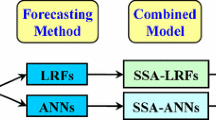Abstract
In this paper, we propose a combination of an adaptive noise-reduction algorithm based on Singular-Spectrum Analysis (SSA) and a standard feedforward neural prediction model. We test the forecast skill of our method on some short real-world and computergenerated time series with different amounts of additive noise. The results show that our combined technique has better performances than those offered by the same network directly applied to raw data, and therefore is well suited to forecast short and noisy time series with an underlying deterministic data generating process (DGP).
Similar content being viewed by others
References
S. Makridakis, M. Hibon. Accuracy of forecasting: an empirical investigation.Journal of the Royal Statistical Society A, vol. 142, pp. 97–145, 1979.
A.S. Weigend, N.A. Gershenfeld (eds.).Time Series Prediction. Forecasting the Future and Understanding the Past, Addison-Wesley Publ. Co., Reading, MA, 1994.
R. Vautard, P. Yiou, M. Ghil. Singular-spectrum analysis: a toolkit for short, noisy and chaotic signals,Physica D, vol. 58, pp. 95–126, 1992.
C.L. Keppenne, M. Ghil. Adaptive filtering and prediction of noisy multivariate signals: an application to subannual variability in atmospheric angular momentum,Internation Journal of Bifurcation and Chaos, vol. 3 (3), pp. 625–634, 1993.
F. Lisi, A. Medio, M. Sandri. Noise filtering with multi-channel singular-spectrum analysis,Working paper No. 94.21 University of Venice}, Ca1 Foscari, Italy, 1995.
C.L. Keppenne, M. Ghil. Adaptive filtering and prediction of the Southern Oscillation Index,Journal of Geophysical Research, vol. 97 (D18), pp. 449–454, 1992.
T. Sauer, J.A. Yorke, M. Casdagli. Embedology.
T. Sauer, J.A. Yorke, M. Casdagli. Embedology,Journal of Statistical Physics, vol. 65 (3/4), pp. 579–616, 1991.
D.S. Broomhead, D.S., G.P. King. On the qualitative analysis of experimental dynamical systems, in:Nonlinear Phenomena and Chaos, S. Sarkar (ed.), Adam Hilger, Bristol, pp. 113–144, 1986.
F. Lisi. Statistical dimension estimation in singular spectrum analysis.Working Paper No. 1994.10, Dept. of Statistics, University of Padua, Italy, 1994.
E.A. Wan. Time series prediction by using a connectionist network with internal delay lines, in:Time Series Prediction. Forecasting the Future and Understanding the Past, A.S. Weigen, N.A. Gershenfeld (eds.), Proceedings Vol. XV, Santa Fe Institute, Addison Wesley, pp. 195–217, 1994
Author information
Authors and Affiliations
Rights and permissions
About this article
Cite this article
Lisi, F., Nicolis, O. & Sandri, M. Combining Singular-Spectrum Analysis and neural networks for time series forecasting. Neural Process Lett 2, 6–10 (1995). https://doi.org/10.1007/BF02279931
Issue Date:
DOI: https://doi.org/10.1007/BF02279931




